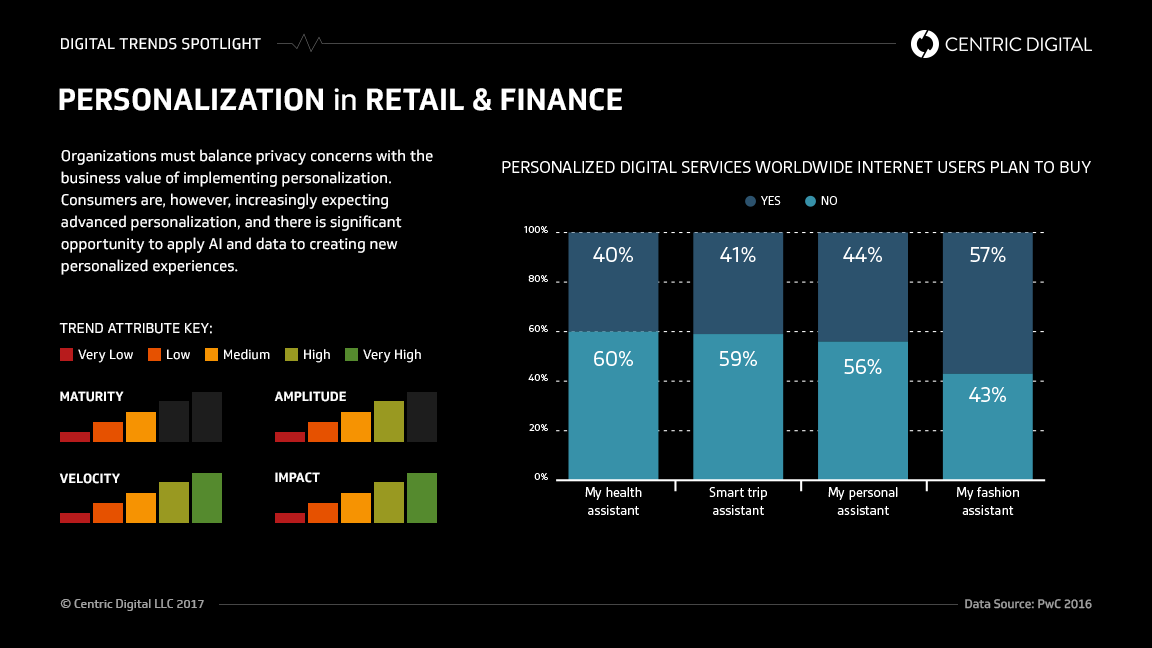copyright by centricdigital.com
Personalization still a major challenge
Businesses across all industries are increasingly aggregating consumer data from smart devices, web platforms, and even in-store interactions, consciously dismantling barriers between channels . The immediate aim of this channel convergence is to deliver curated, highly personalized experiences that remain consistent across all touchpoints. The ultimate goal is to grow sales and boost retention by offering customers precisely what they’re looking for through sophisticated personalization strategies. Here’s a closer look at how the retail and financial services industries are using what they learn through personalization to make the right business decisions.
Overcoming Barriers
In a study conducted by artificial intelligence platform Kahuna , 36 percent of marketers still find that personalization is a major challenge. While the ability to narrowly segment demographic groups is increasingly important for companies to make decisions about products and marketing, fewer than 10 percent of top retailers responding to the survey currently feel that their personalization strategies are “highly effective.” Almost half of retailers struggle with the limitations of their legacy technology , and 32 percent simply say that they don’t have the technology available for digital personalization. Meanwhile, more than 48 percent of senior marketers acknowledge that good personalization will improve response rates, increase sales and enhance brand identity.
 Reaching the customers through AI
Reaching the customers through AI
Despite these impediments, however, many retailers have taken bold steps toward improving their customer experience through targeted communications that make interactions easier. Artificial intelligence (AI) opens up a broad set of opportunities, and some of the biggest legacy names are taking advantage of these. As the majority of online interactions shift to handheld devices, retailers who prioritize their mobile apps are reaping benefits. For these forward-thinking retailers, apps generate over 50 percent of mobile revenue. As customers download a store’s app, they input some of their information in order to customize it based on their needs. Touchpoints further within the app enable customers to set more detailed preferences, thus allowing stores to deliver highly targeted content and recommendations. Clothing and accessories retailer Tilly’s saw a 40 percent increase in conversion rate after they added personalized suggestions to their mobile app […]
read more – copyright by centricdigital.com


copyright by centricdigital.com
Personalization still a major challenge
Businesses across all industries are increasingly aggregating consumer data from smart devices, web platforms, and even in-store interactions, consciously dismantling barriers between channels . The immediate aim of this channel convergence is to deliver curated, highly personalized experiences that remain consistent across all touchpoints. The ultimate goal is to grow sales and boost retention by offering customers precisely what they’re looking for through sophisticated personalization strategies. Here’s a closer look at how the retail and financial services industries are using what they learn through personalization to make the right business decisions.
Overcoming Barriers
In a study conducted by artificial intelligence platform Kahuna , 36 percent of marketers still find that personalization is a major challenge. While the ability to narrowly segment demographic groups is increasingly important for companies to make decisions about products and marketing, fewer than 10 percent of top retailers responding to the survey currently feel that their personalization strategies are “highly effective.” Almost half of retailers struggle with the limitations of their legacy technology , and 32 percent simply say that they don’t have the technology available for digital personalization. Meanwhile, more than 48 percent of senior marketers acknowledge that good personalization will improve response rates, increase sales and enhance brand identity.
Despite these impediments, however, many retailers have taken bold steps toward improving their customer experience through targeted communications that make interactions easier. Artificial intelligence (AI) opens up a broad set of opportunities, and some of the biggest legacy names are taking advantage of these. As the majority of online interactions shift to handheld devices, retailers who prioritize their mobile apps are reaping benefits. For these forward-thinking retailers, apps generate over 50 percent of mobile revenue. As customers download a store’s app, they input some of their information in order to customize it based on their needs. Touchpoints further within the app enable customers to set more detailed preferences, thus allowing stores to deliver highly targeted content and recommendations. Clothing and accessories retailer Tilly’s saw a 40 percent increase in conversion rate after they added personalized suggestions to their mobile app […]
read more – copyright by centricdigital.com
Share this: